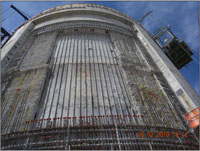Rather than shutting down its cracked Crystal River Nuclear Plant 3 in Citrus County, Progress Energy Florida will seek approval from the Nuclear Regulatory Commission and the state of Florida for up to $1.3 billion in additional repairs to the out-of-commission facility, likely keeping it offline until 2014.


The plant has been shut down since 2009, when Progress initiated a planned refueling and replacement of its steam generators. In October 2009, workers for SGT, Charlotte, N.C., the contractor performing this work, were creating an opening in the structure to facilitate generator replacement when they discovered severe internal cracking in the concrete, referred to as delamination, at the periphery of the containment building. Analysis revealed the delamination occurred between horizontal tendon sleeves.
SGT repaired the delamination in the bay where it occurred by removing and replacing the section’s concrete and retensioning the steel tendons. Then, this past March, Progress was in the final stages of retensioning the building and returning the unit to service when a second, more significant delamination occurred in another section of the containment structure.
Analysis revealed the existing concrete’s tensile strength was insufficient to withstand the stresses.
“The tensile strength of the concrete was not strong enough to withstand the shear stress along the plane of the tendons when the building was detensioned and the opening was cut,” said Bill Johnson, Progress Energy’s president, chairman and CEO, during a June 28 conference call.
Johnson said the utility reviewed all options, including shutting down the plant. SGT, which is jointly owned by AREVA and URS, performed the analysis of options, with additional support from Bechtel.
“Based on our best information today, we believe it is prudent to repair Crystal River 3, rather than to decommission the plant,” Johnson said.
Repairs would consist of repeating roughly the same methods used to fix the first, cracked section of the containment building in the other five bays: replacing the steel-reinforced concrete and retensioning the structure. The current estimates for repairs range from $900 million to $1.3 billion. Johnson said further engineering would take a “number of months” to conduct, and that additional engineering analyses and designs could affect the final repair plan.
If approved by the NRC and the Florida Public Service Commission, the repair work would be put out to bid, says Mike Hughes, Progress Energy spokesperson. Progress will present its repair plan to the FPSC on July 14, and expects to determine a project timetable shortly thereafter. Johnson said construction could begin by 2012, with the goal of completing repairs and getting the plant back in service by 2014.
Through May, Progress has spent approximately $214 million on repairs. Progress expects that most of the repair costs would be covered by the $2.25 billion in property-damage insurance that the company maintains for Crystal River. The utility says the nuclear plant, in service since 1977, is its lowest-cost resource to operate.
The utility’s license with the NRC for Crystal River 3 expires in 2016. Progress filed for a license renewal in 2008.


